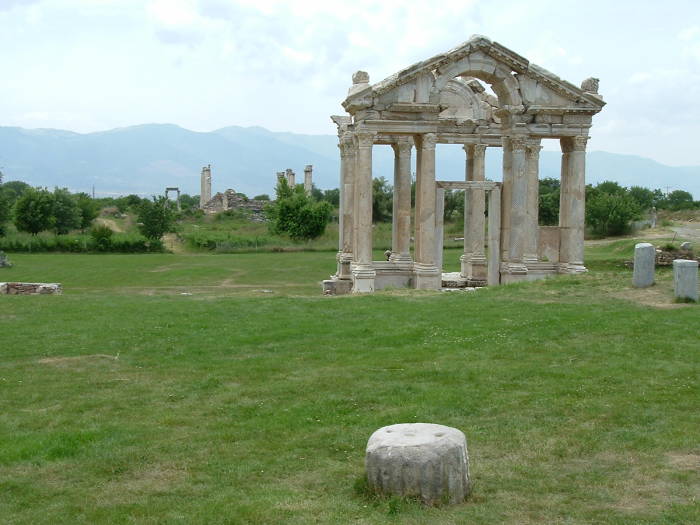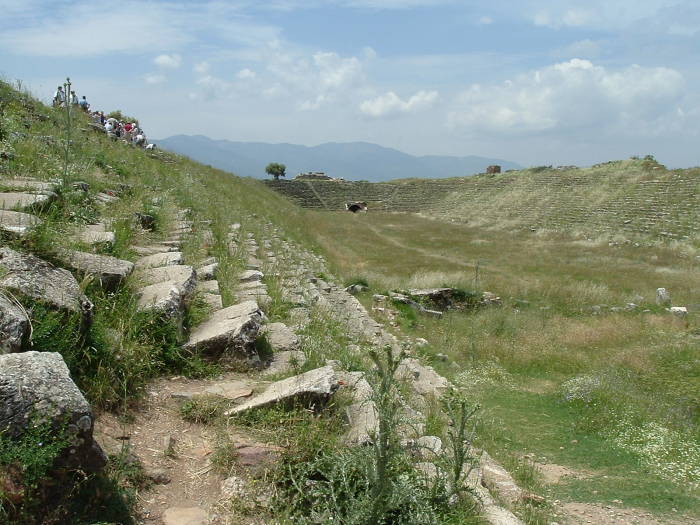
Aphrodisias
An Ancient Greek Temple Complex in the Mountains of Southwestern Turkey
Background
The ancient Greeks put great importance on the setting of a potential religious center, and Αφροδισιάς or Aphrodisias is a good example of when they got it right. It's in a great setting, with the temples framed by distant mountains. The city was built near a marble quarry, and the sculptors working in Aphrodisias were among the best. The style of the local carvers has been recognized in statues found throughout the Greek and Roman empires.
Aphrodisias is south-west of Denizli near the village of Geyre. However, you can't get there from Denizli along anything close to a straight line due to the rugged terrain. Expect to spend most of a day visiting Aphrodisias on a day-trip out of Denizli or Pamukkale. The pensions in Pamukkale can help you set this up. Hired vans go to Aphrodisias most days during the busy season, and many days during slower seasons.
Aphrodisias was an important city under Greek and later Roman rule. In later years it because a significant Christian city, getting a name change around 640 AD to "Stauropolis", or "City of the Cross", replacing the earlier "City of Aphrodite".
Pictures
This is the Tetrapylon, or monumental gate. The main axis of the city was aligned with the distant mountains. The Tetrapylon was at one end of this axis.
The ancient Greeks placed great importance on the location and orientation of sacred architecture. The surrounding mountains are a vital aspect of the temple setting. You can see here how distant mountains and passes would frame and be framed by the Tetrapylon.

As described in the August, 1967 National Geographic article "Ancient Aphrodisias and Its Marble Treasures", the site was settled back in the Bronze Age. A cemetery and other remains date back to 3000-2200 BC.
You see the distant mountains as you look toward the east through the Tetrapylon.

Modern tombs indicate that the Turkish village of Geyre was founded on the site by the 17th or 18th century. "Eski Geyre", or "Old Geyre" as this settlement is now called, was built up within the original city walls. The village's Turkish name was based on Caria or Καρία, the Ancient Greek name for the region, itself derived from the Luwian Karuwa meaning "Steep Country".
Caria was in the southwestern corner of Anatolia, with Aphrodite at its northeastern corner. The original Carian people had arrived there before the Greeks arrived. Herodotus said they were of Minoan descent, although their own tradition was that they were sea-going Anatolians. The Carian language was Anatolian, but that doesn't necessarily mean they came from Anatolia as that language family may have been widespread.
As for the rediscovery of the ruins, the French railroad engineer Paul Gaudin excavated at Aphrodisias in 1904-1905.
Nothing happened until the Italian scholar Giulio Jacopi worked here for just a few weeks in 1937, making some significant finds in a short time.
The site was ignored after Gaudin's excavation because of its isolation at the time, and World War II started soon after Jacopi's short expedition.
The National Geographic article describes the villagers as having been relocated around 1957-1959 to a newly built Yeni Geyre (or New Geyre) a couple of kilometers to the west. Excavations began again around 1961.
Very fine white and blue-gray marble was quarried from nearby mountain slopes. The city's sculptors soon gained regional and broader fame for their work on the main Temple of Aphrodite as well as the other city monuments.
Traveling salesmen sold Aphrodisian sarcophagi throughout the Roman Empire. They offered precarved sarcophagi with the heads only blocked out roughly, so they could be finished in the image of the purchasers. Residents of the past two centuries have used remaining sarcophagi as wine presses and laundry tubs.

Artists came to Aphrodisias for training, and then set up workshops throughout the Empire. The Aphrodisian school of sculpture decorated the homes of the Caesars and the Roman aristocracy. Italian based sculptors including Koblanos, Aristeas, Papias, and Antonianos included Aphrodisieus (of Aphrodisias) in their signatures on their works.
Here we are looking the opposite direction through the Tetrapylon, across the city center toward the Temple of Aphrodite and the mountain range west of the city.

The Temple of Aphrodite was the primary sacred structure. Not much remains today beyond two rows of columns, the floor, and at least low outlines of some of the entrances and walls.
The original cult figure here was an Anatolian mother-goddess named Nin or Nina. She was similar to Ishtar (or Astarte), a goddess of love, fertility, and sexuality. The city was known as Νινόη or Ninóe in her honor. It later went through the names Μεγάλη Πόλις, Megale Polis or "Great City", and Λελέγων Πόλις, or "City of the Leleges".

Greeks started arriving in northern Caria after Alexander the Great's forced moved through Asia Minor in 334 BC. They always identified the local deities in their new surroundings with their own gods and goddesses. The goddess and city were renamed to give us Aphrodite of Aphrodisias. This was similar to how the mother-goddess of Ephesus was identified with Artemis even though she bore little resemblance to the classical Greek goddess.
Aphrodite of Aphrodisias, like the modified Artemis of Ephesus, was represented wearing a thick and form-disguising tunic. That's right — Aphrodite in a heavy coat! Nothing like the gauzy lingerie associated with the classical image we have of Aphrodite, the goddess of love!
She was represented with her feet close together, her forearms stretched forward to receive and give, wearing necklaces, a heavy crown, a diadem, and a wreath of myrtle. A long veil framed her face and hung to the ground. Stranger yet — a veil on Aphrodite!
Greek literature says very little about the city of Aphrodisias. It suddenly appears in the Roman historical record in the first century BC. Appian stated in 82 AD that the Roman dictator Sulla was directed by the Oracle of Delphi to send gifts in the form of a golden crown and a double ax to the Carian Aphrodite in order to gain power and good fortune. Mark Antony followed the wishes of Julius Caesar and decreed that the city was inviolate, exempt from payment of tribute, and its temple had the power to offer asylum to outcasts.
There was a connection at work. The building program in the city center was initiated and largely funded by Gaius Julius Zoilus, a Aphrodisian who had been a slave of Gaius Julius Caesar and who had been set free by Octavian. Zoilus had returned home wealthy and directed his city to align it with Octavian in his power stuggle against Mark Antony.
Severe earthquakes heavily damaged the city around 350.
Around 640 the city was renamed as Σταυρούπολις, Stauropolis, or the "City of the Cross". The Temple of Aphrodite was heavily altered as it was converted into a Christian basilica. It was the seat of a bishop in Byzantine times.
Michel Le Quien, a French historian and theologian, listed some twenty bishops in his Oriens christianus, including these who took part in significant early church councils:
Ammonius, who was at the First Council of Nicæa in 325.
Eumenius, who was at the First Council of Constantinople. in 381
Cyrus, who was at the First Council of Ephesus. in 431
Critonianus, who was at the Council of Chalcedon in 451.
Severianus, who was at the Second Council of Constantinople. in 553
During the 600s there were twenty-eight suffragan bishops in Stauropolis (that is, bishops subordinate to a metropolitan bishop or diocesan bishop, possibly assigned to areas which do not have cathedrals of their own).
From the 1000s through the 1200s, waves of Seljuk Turks and Turkoman forces rampaged through the area, devastating what little remained of the city. Earthquakes just added to the destruction.
The bishop's see was abandoned between 1356 and 1361.
The stadium could have seated 20,000 to 30,000 spectators back in the day. Anyway, it was a long and narrow stadium with several rows of seats. It was just the thing for staging and watching foot races and contests of javelin, discus, and shot throwing. All, of course, performed in the nude.

The name "stadium" is based on the ancient Greek measure of length, the stadion or στάδιον. The precise distance varied, but a stadion was about 185 meters as measured in Attica. It was based on 600 podes (or ποδες) each pous (or ποϋς) being about 296 mm in Attic Greece, with the Aeginan pous more like 333 mm.